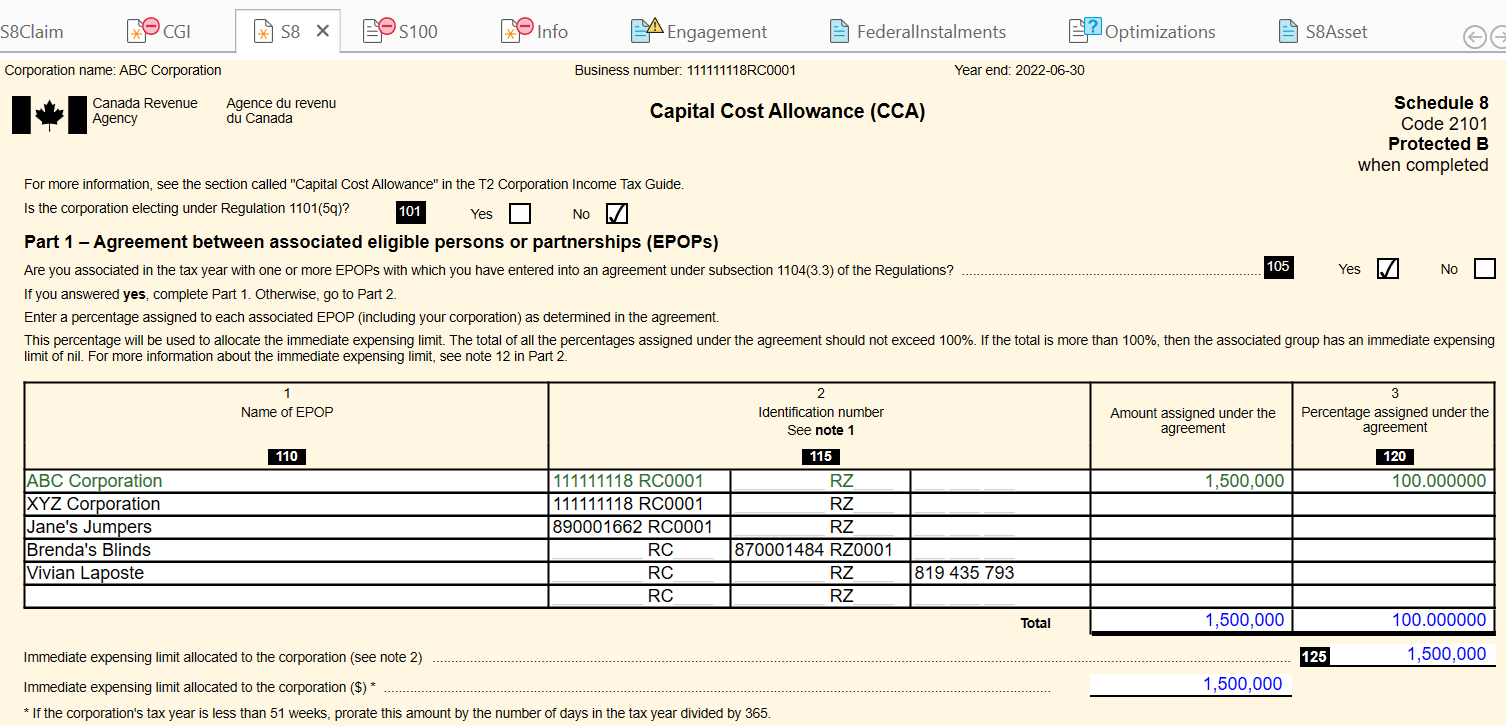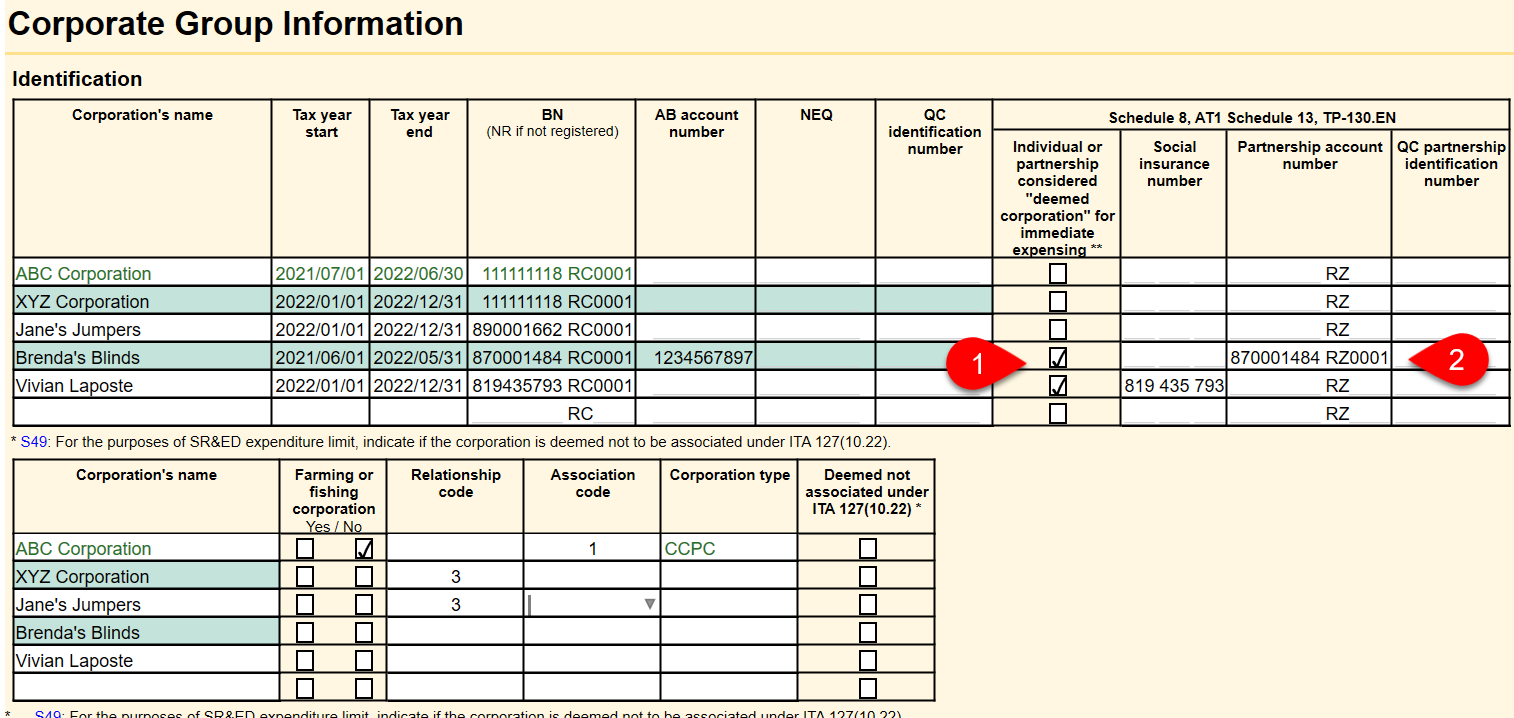Updated: 2023-03-30
This topic covers immediate expensing for corporate and partnership tax returns, in TaxCycle T2 and TaxCycle T5013. To learn how to apply the measure to personal tax returns, see T1 Immediate Expensing of CCA.
The Department of Finance has introduced a temporary tax incentive measure called “immediate expensing incentive”. This incentive allows an eligible person or partnership (EPOP) to immediately expense costs of certain depreciable capital property (known as “immediate expensing property”) in the year of acquisition up to an annual maximum limit of $1.5 million. This annual limit is called the immediate expensing limit and it must be shared with any associated EPOPs. This limit is subject to proration if a tax/fiscal year of an EPOP is less than 51 weeks.
The following abbreviations are used throughout this topic.
An EPOP is defined as:
(a) a corporation that was a Canadian-controlled private corporations (CCPC) throughout the year;
(b) an individual (other than a trust) who was resident in Canada throughout the year; or
(c) a Canadian partnership, all of the members of which were, throughout the period, persons described in paragraphs (a) or (b).
IEP refers to eligible capital asset additions and is defined as property of a prescribed class other than property included in any of Classes 1 to 6, 14.1, 17, 47, 49 and 51. If the EPOP is:
In order to apply immediate expensing incentive, an EPOP must “designate” IEP as DIEP (“designated immediate expensing property”). This designation occurs automatically through preparing a CCA schedule (such as Schedule 8 for T2 or T5013).
In accordance with the definition of an EPOP, above, for the purposes of sharing the immediate expensing limit among associated EPOPs, a CCPC may be considered associated with an individual or a partnership. When preparing a T2 return, you must complete the table in Schedule 8 Part 1 accordingly.
A CCPC with a capital cost of IEP that exceeds $1.5 million in a taxation year, and that has immediate expensing property ordinarily included in more than one CCA class, can decide which CCA class to attribute the immediate expensing incentive. Any remaining UCC may be subject to additional capital cost allowance deductions under the existing CCA rules (AIIP).
The amount of immediate expensing deduction allowed to be deducted is equal to the lesser of:
(a) the EPOP’s immediate expensing limit for the taxation year (all or portion of the $1.5 million limit);
(b) the UCC to the EPOP as of the end of the taxation year (before making immediate expensing deduction) of property that is DIEP for the taxation year, and
(c) if the EPOP is not a CCPC, the amount of income, if any, earned from the source of income that is a business or property (computed without regard to paragraph 20(1)(a) of the Act) in which the relevant DIEP is used for the eligible person or partnership's taxation year.
VERY IMPORTANT! Point (c), above, applies only to individuals (T1) and partnerships (T5013). Eligible individuals and partnerships cannot claim immediate expensing deduction to create or increase a loss. For example, if an individual carries on a self employment business which has $10,000 of net income before CCA, recapture and terminal loss, the maximum amount of immediate expensing amount cannot exceed $10,000.
For example, an EPOP (CCPC) invests $3,000,000 in equal amounts to acquire the following three properties:
Although the CCPC could designate any of the three properties as DIEP, it is expected that it would generally designate, for purposes of the immediate expensing incentive, starting with property that falls under CCA classes that would otherwise offer the lowest CCA deduction. By doing so, the EPOP would be able to maximize its CCA claim. Simply put, the CCA claim is maximized if the immediate expensing incentive is applied to class 7, class 10, and then class 50—in this order—as illustrated below.
| CCA Class (rate) | Cost of Acquisitions |
Immediate Expensing |
1st year Allowance on Remainder of Class |
Total First-Year Allowance |
|---|---|---|---|---|
| Class 7 (15%) | $1,000,000 | $1,000,000 | $0 | $1,000,000 |
| Class 10 (30%) | $1,000,000 | $500,000 | $225,000 | $725,000 |
| Class 50 (55%) | $1,000,000 | $0 | $825,000 | $825,000 |
| Total | $3,000,000 | $1,500,000 | $1,050,000 | $2,550,000 |
TaxCycle offers two ways of calculating immediate expensing incentive, depending on how you answer the following question on the S8Claim worksheet in T2 and T5013 returns:


The CRA issued a new T2 Schedule 8 (T2SCH8) to allow eligible corporations to claim immediate expensing. This new version includes a table in Part 1 for allocating the $1.5 million limit among associated EPOPs.

In addition, the Part 2 CCA table contains extra columns to accommodate the immediate expensing calculation.
TaxCycle automatically completes the Part 1 table when you enter associated corporation information on the Corporate Group Information (CGI) worksheet.

An immediate expensing deduction is calculated to be the lesser of:
The S8Asset in the 2022 T2 modules contains a section to calculate the deduction accordingly.


If, after entering the addition, the corporation is eligible to claim immediate expensing deduction, TaxCycle will automatically calculate immediate expensing.
However, if you answered "Yes" to the question on the S8Claim to enter the claim manually, TaxCycle displays a Quick Fix review message prompting you to enter an amount for the immediate expensing limit. Click one of the links in this message to enter the immediate expensing limit just for that particular asset or for all the assets in all CCA classes.

After you enter the limit, TaxCycle automatically calculates the immediate expensing deduction and includes it in the total CCA claim field.
